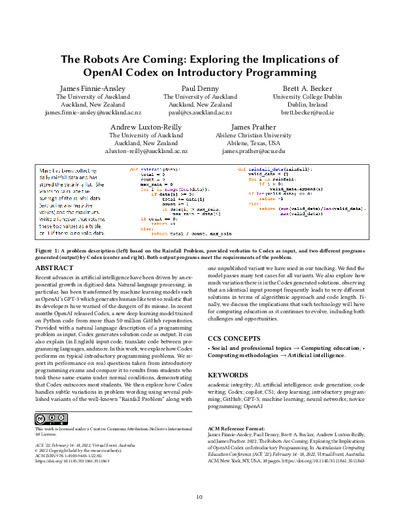The Robots Are ComingExploring the Implications of OpenAI Codex on Introductory Programming
Publikationsdatum:
|
 |
 Diese Seite wurde seit 1 Jahr inhaltlich nicht mehr aktualisiert.
Unter Umständen ist sie nicht mehr aktuell.
Diese Seite wurde seit 1 Jahr inhaltlich nicht mehr aktualisiert.
Unter Umständen ist sie nicht mehr aktuell.
 Zusammenfassungen
Zusammenfassungen
Von Beat Döbeli Honegger, erfasst im Biblionetz am 18.12.2022
Recent advances in artificial intelligence have been driven by an exponential growth in digitised data. Natural language processing, in
particular, has been transformed by machine learning models such
as OpenAI’s GPT-3 which generates human-like text so realistic that
its developers have warned of the dangers of its misuse. In recent
months OpenAI released Codex, a new deep learning model trained
on Python code from more than 50 million GitHub repositories.
Provided with a natural language description of a programming
problem as input, Codex generates solution code as output. It can
also explain (in English) input code, translate code between programming languages, and more. In this work, we explore how Codex
performs on typical introductory programming problems. We report its performance on real questions taken from introductory
programming exams and compare it to results from students who
took these same exams under normal conditions, demonstrating
that Codex outscores most students. We then explore how Codex
handles subtle variations in problem wording using several published variants of the well-known “Rainfall Problem” along with one unpublished variant we have used in our teaching. We find the
model passes many test cases for all variants. We also explore how
much variation there is in the Codex generated solutions, observing
that an identical input prompt frequently leads to very different
solutions in terms of algorithmic approach and code length. Finally, we discuss the implications that such technology will have
for computing education as it continues to evolve, including both
challenges and opportunities.
Von James Finnie-Ansley, Paul Denny, Brett A. Becker, Andrew Luxton-Reilly, James Prather im Text The Robots Are Coming (2022)  Dieses Konferenz-Paper erwähnt ...
Dieses Konferenz-Paper erwähnt ...
 Personen KB IB clear | Sandhini Agarwal , Dario Amodei , Amanda Askell , Brett A. Becker , Christopher Berner , Tom B. Brown , Heather E. Bullock , Angela Carbone , Mark Chen , Benjamin Chess , Rewon Child , Jack Clark , Beth Cook , Kewal Dhariwal , Prafulla Dhariwal , Kelly Downey , Alex D. Edgcomb , Julian Fernald , Kathi Fisler , Scott Gray , Mark Guzdial , Tom Henighan , Ariel Herbert-Voss , Christopher Hesse , Petri Ihantola , Essi Isohanni , Ville Isomöttönen , Chris W. Johnson 0002 , Jared Kaplan , Gretchen Krueger , Antti-Jussi Lakanen , Vesa Lappalainen , Mateusz Litwin , Andrew Luxton-Reilly , Benjamin Mann , Sam McCandlish , Charlie McDowell , Joe Michael Allen , Kris Miller , Elon Musk , Arvind Neelakantan , Keith Quille , Alec Radford , Aditya Ramesh , Nick Ryder , Girish Sastry , Otto Seppälä , Judy Sheard , Pranav Shyam , Eric Sigler , Simon , Elliot Soloway , Juha Sorva , Melanie Subbiah , Ilya Sutskever , Frank Vahid , Arto Vihavainen , Linda L. Werner , Clemens Winter , Jeffrey Wu , Daniel M. Ziegler | |||||||||||||||||||||||||||||||||||||||||||||||||||||||||||||||||||||||||||||||||||||||||||||||||||
 Begriffe KB IB clear |  Algorithmus Algorithmus algorithm
, algorithm
,  deep learning
, deep learning
,  Generative Machine-Learning-Systeme (GMLS) Generative Machine-Learning-Systeme (GMLS) computer-generated text
, computer-generated text
,  Generative Pretrained Transformer 3 (GPT-3)
, Generative Pretrained Transformer 3 (GPT-3)
,  GPT-2
, Informatikcomputer science
, Informatik-Didaktikdidactics of computer science
, Informatik-Unterricht (Fachinformatik)Computer Science Education
, GPT-2
, Informatikcomputer science
, Informatik-Didaktikdidactics of computer science
, Informatik-Unterricht (Fachinformatik)Computer Science Education
,  Künstliche Intelligenz (KI / AI) Künstliche Intelligenz (KI / AI) artificial intelligence
, artificial intelligence
,  Lernen Lernen learning
, learning
,  machine learning
, machine learning
,  Programmieren Programmieren programming
, Programmiersprachenprogramming languages
, rainfall problem programming
, Programmiersprachenprogramming languages
, rainfall problem
| |||||||||||||||||||||||||||||||||||||||||||||||||||||||||||||||||||||||||||||||||||||||||||||||||||
 Bücher |
| |||||||||||||||||||||||||||||||||||||||||||||||||||||||||||||||||||||||||||||||||||||||||||||||||||
 Texte |
|
 Dieses Konferenz-Paper erwähnt vermutlich nicht ...
Dieses Konferenz-Paper erwähnt vermutlich nicht ... 
 Nicht erwähnte Begriffe | blockbasierte Programmierumgebungen, Chat-GPT, Generative Pretrained Transformer 4 (GPT-4), GMLS & Bildung, Informatikunterricht in der Schule |
 Tagcloud
Tagcloud
 Zitationsgraph
Zitationsgraph
 Zitationsgraph (Beta-Test mit vis.js)
Zitationsgraph (Beta-Test mit vis.js)
 Zeitleiste
Zeitleiste
 4 Erwähnungen
4 Erwähnungen 
- The dawn of AI has come, and its implications for education couldn’t be more significant (Vitomir Kovanovic) (2022)


- ChatGPT und andere Computermodelle zur Sprachverarbeitung - Grundlagen, Anwendungspotenziale und mögliche Auswirkungen (Steffen Albrecht) (2023)


- Informatikunterricht zwischen Aktualität und Zeitlosigkeit - 20. GI-Fachtagung Informatik und Schule (Lutz Hellmig, Martin Hennecke) (2023)


- KI für Lehrkräfte - ein offenes Lehrbuch (Colin de la Higuera, Jotsna Iyer) (2024)


 Anderswo finden
Anderswo finden
 Volltext dieses Dokuments
Volltext dieses Dokuments
 |  The Robots Are Coming: Artikel als Volltext ( The Robots Are Coming: Artikel als Volltext ( : :  , 895 kByte; , 895 kByte;  : :  ) ) |
 Anderswo suchen
Anderswo suchen 
 Beat und dieses Konferenz-Paper
Beat und dieses Konferenz-Paper
Beat hat Dieses Konferenz-Paper während seiner Zeit am Institut für Medien und Schule (IMS) ins Biblionetz aufgenommen. Beat besitzt kein physisches, aber ein digitales Exemplar. Eine digitale Version ist auf dem Internet verfügbar (s.o.). Es gibt bisher nur wenige Objekte im Biblionetz, die dieses Werk zitieren.




















 Biblionetz-History
Biblionetz-History